John W Waterhouse
-
- Aluminum Gone "Bad" Maritime Reporter, May 2003 #42
There has been a lot of discussion in the marine industry over the past year with regard to "bad" aluminum. To briefly recap, a number of boat builders purchased aluminum from a supplier that met the requirements of ASTM 5083 H321. This alloy is accepted by both Lloyds Register (Lloyds) and Det Norske Veritas (DNV) for building aluminum vessels. After the aluminum was used to construct some vessels, the operators began to observe surface pitting corrosion. Upon investigation, it was discovered that the purchased plate had been treated differently during manufacturing, with the result that manganese nodules were precipitating out of the alloy, thus making it susceptible to intergranular corrosion. The result was that newly-built vessels had to be rebuilt and their original hulls scrapped. Owners weren't able to use their new boats, shipyards incurred costs to investigate and rebuild, and the aluminum distributor and provider are faced with claims. Not good all around.
In response to the investigation, the ASTM International Committee B07 and the Aluminum Association have been meeting with the U.S. Coast Guard and industry members to review and improve the relevant standards.
Classification societies such as Lloyds, DNV, and ABS are also involved in the discussions. Beyond testing for chemical composition and mechanical properties, the standard will likely be expanded to include corrosion tests. Plates that have been tested and passed as suitable for marine use will also be marked clearly to prevent inadvertent mixing with non-marine aluminum. All of these measures should prevent a repeat appearance of unsuitable aluminum in high speed ferries and workboats.
As a designer of vessels, I am concerned that there is a more significant challenge that hasn't been addressed — namely the increasing use of third party standards in the marine industry. As vessels become more complex and more international in their design and construction, there is ample opportunity for misapplication of standards. Yet, there are increasing pressures on regulatory bodies such as the U.S. Coast Guard to use third party standards. For example, years ago the U.S. Coast Guard had developed a fire testing standard for marine interior materials. The problem for the industry was that this standard was different from the more common fire testing standards, thus forcing manufacturers to conduct expensive tests if they wanted to implement their products into the marine industry. The problem for the U.S. Coast Guard was to keep up with changes in materials and testing procedures so their standard did not become obsolete. Hence, as part of the rewrite of the Guide to Structural Fire Protection, NVIC 9-97, the U.S. Coast Guard now accepts Universal Laboratories, ASTM, and IMO standards for construction and testing of fire doors. Industry benefits by having more choice, manufacturers benefit by fewer tests, and the U.S. Coast Guard benefits by having others take on the burden of writing and updating standards.
I have been involved with several standards development committees, the ABS Americas Small Vessel Committee, NFPA 1925 - Marine Firefighting Vessels, and the Passenger Vessel Access Advisory Committee. It is both an enriching and a humbling process.
Enriching because you learn details about the subjects that you could never learn elsewhere. Humbling because standards often reflect compromises between strong opinions.
Therein lies my concern about third party standards. We often invoke them without really understanding what the standards say or, as in the case of the aluminum alloy specification, what they don't say (i.e. no corrosion test). Often there is no record of how the standard was chosen since committee discussions are seldom recorded. For example, the ADA minimum standard width for doorways is 32 in. Most people mistakenly associate that standard with wheelchairs.
Actually, the width was chosen because it is the minimum practical width for persons with crutches to readily pass through the doorway.
Designers, builders, and operators are dealing with an ever increasing number of standards. The alphabet soup of ASTM, ANSI, ICS, ABYC, IEEE, NFPA, ISO, IEC, etc. is confusing.
Obtaining copies of all of the relevant documents is aboth expensive and ongoing as the standards are revised.
Reading the standards takes time and lots of caffeine to stay awake. The natural tendency is to assume that the code writers knew what they were doing so "use the standards and don't waste time on researching the details." I don't have a solution to this challenge.
I certainly encourage industry members to get involved by working on a standards committee. As an industry, we shouldn't rely upon others to make decisions that will affect our future. We also need to share our discoveries with others so we are all smarter. Just think about crutches the next time you pass through a doorway...and read the fine print when you order aluminum.
-
- Sea-Kindly: A Steady Vessel by Design Maritime Reporter, Oct 2001 #26
is an important characteristic of any vessels. Motion, energy and design play key roles in the sea kindliness of a vessel. How friendly is yours? John W. Waterhouse, P.E. received his B.S. in Mechanical Engineering from U.C. Berkeley in 1979 and his M.S. in Naval Architecture and Marine Engineering from
-
- A Naval Architect's Look At Design Trends Maritime Reporter, Jun 2002 #24
Reading tea leaves on a boat underway is an exercise in frustration because just as the leaves start to settle, another wave comes along and changes the picture. Similarly, trying to foresee trends in the marine industry. Just as you see things shaping up, a change occurs and the industry is re-shujfle
-
- Price, Quality, Schedule Maritime Reporter, Jan 2003 #35
That's the sign I saw once in a Maine boatyard. Big, bold letters. Underneath it said, "Pick two". That's the dilemma for any provider of goods or services. Low price, high quality, quick schedule. Our customers want all three objectives, our industry often has challenges in providing just one
-
- Committees, Associations, and Societies Maritime Reporter, Apr 2003 #61
Last Fall I had the opportunity to attend the Southeast Conference in Craig, Alaska. This conference is an association of communities working together on common issues such as transportation, their regional economy, and outside influences on their region such as the federal government. It is a great
-
- Alternative Ferry Propulsion Systems: A Case Study Marine News, Mar 2017 #24
Is it Right for Your Operation? That Depends, says EBDG’s John Waterhouse. Elliott Bay Design Group (EBDG) serves many ferry customers in North America. These clients read the trade publications and see various articles on new technologies such as hybrid propulsion, battery powered vessels or zero
-
- Ferry Boat Interiors Maritime Reporter, Jan 2004 #24
It is late in the day and you are anxious to get home. You drive onboard the ferry, park your car and head up to the passenger lounge. As you pass through the door at the top of the stairs, what will you see and experience? That is the challenge in designing ferry interiors. As a naval architect I
-
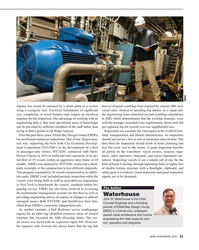 )
June 2021 - Maritime Reporter and Engineering News page: 21
)
June 2021 - Maritime Reporter and Engineering News page: 21in reviewing the maintenance management systems for this ? eet as well as Waterhouse providing engineering advice on repairs or changes to address John W. Waterhouse is the Chief emergent issues. Both NYCEDC and Hornblower have ben- Concept Engineer and a founding e? ted from EBDG’s consistent, independen
-
 )
June 2021 - Maritime Reporter and Engineering News page: 4
)
June 2021 - Maritime Reporter and Engineering News page: 4issues stream and renewables focused editor of Offshore Engineer and in maritime. journalist, based in Scotland. OEDigital.com. Waterhouse Meyer Tortora John W. Waterhouse is the Chief Business Publications Audit of Circulation, Inc. Søren took on the CEO role for Captain Sean P. Tortora is a Concept
-
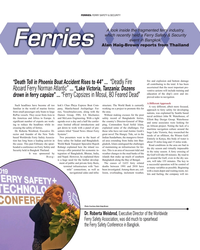 )
May 2019 - Maritime Reporter and Engineering News page: 58
)
May 2019 - Maritime Reporter and Engineering News page: 58excuses for the poor the Americas and Africa to Europe. A and McLaren Engineering. With a tight safety record of Bangladeshi ferries, naval architect John W. Waterhouse, of Elliott Bay Design Group. Waterhouse signi? cant number of experts are work- agenda over a day and a half the confer- the country’s
-
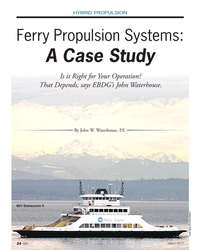 )
March 2017 - Marine News page: 24
)
March 2017 - Marine News page: 24HYBRID PROPULSION Ferry Propulsion Systems: A Case Study Is it Right for Your Operation? That Depends, says EBDG’s John Waterhouse. By John W. Waterhouse, P.E. M/V Steilacoom II Credit: Nichol Bros Boat Builders March 2017 24 MN
-
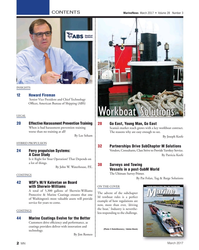 )
March 2017 - Marine News page: 2
)
March 2017 - Marine News page: 2Systems: A Case Study By Patricia Keefe Is it Right for Your Operation? That Depends on a lot of things. 38 Surveys and Towing By John W. Waterhouse, P.E. Vessels in a post-SubM World The Ultimate Survey Primer. COATINGS By Pat Folan, Tug & Barge Solutions 42 WSF’s M/V Kaleetan
-
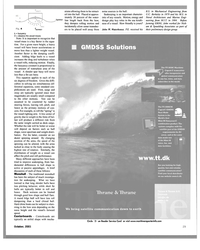 )
October 2001 - Maritime Reporter and Engineering News page: 29
)
October 2001 - Maritime Reporter and Engineering News page: 29is an important character- istic of any vessels. Motion, energy and design play key roles in the sea kindli- ness of a vessel. How friendly is yours? John W. Waterhouse, P.E. received his B.S. in Mechanical Engineering from U.C. Berkeley in 1979 and his M.S. in Naval Architecture and Marine Engi- neering
-
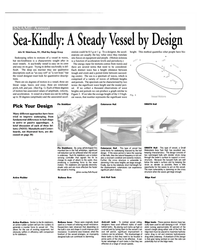 )
October 2001 - Maritime Reporter and Engineering News page: 26
)
October 2001 - Maritime Reporter and Engineering News page: 26Sea-Kindly: A Steady Vessel by Design John W. Waterhouse, P.E., Elliott Bay Design Group Seakeeping refers to motions of a vessel in waves, but sea-kindliness is a characteristic sought after in most vessels. A sea-kindly vessel is easy on its crew and easy on its gear. Trying to define sea-kindly
-
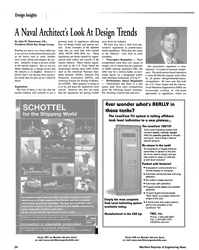 )
June 2002 - Maritime Reporter and Engineering News page: 24
)
June 2002 - Maritime Reporter and Engineering News page: 24Design Insights A Naval Architect's Look At Design Trends By John W. Waterhouse, P.E., President, Elliott Bay Design Group. Reading tea leaves on a boat underway is an exercise in frustration because just as the leaves start to settle, another wave comes along and changes the pic- ture.
-
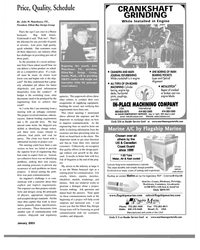 )
January 2003 - Maritime Reporter and Engineering News page: 35
)
January 2003 - Maritime Reporter and Engineering News page: 35Beginning this month, John Waterhouse, P.E., president, Elliott Bay Design Group, Seattle, Wash., will be providing MR/EN readers with insight and innovation withn the passenger vessel industry. Marine A/C by Flagship Marine Price, Quality, Schedule Circle 259 on Reader Service Card or
-
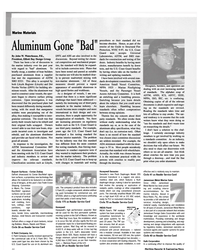 )
May 2003 - Maritime Reporter and Engineering News page: 42
)
May 2003 - Maritime Reporter and Engineering News page: 42Marine Materials Aluminum Gone "Bad" By John W. Waterhouse, P.E., President, Elliott Bay Design Group There has been a lot of discussion in the marine industry over the past year with regard to "bad" aluminum. To briefly recap, a number of boat builders purchased aluminum from a supplier
-
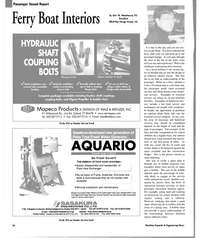 )
January 2004 - Maritime Reporter and Engineering News page: 24
)
January 2004 - Maritime Reporter and Engineering News page: 24Passenger Vessel Report Ferry Boat Interiors By John W. Waterhouse, P.E. President Elliott Bay Design Group, Ltd. HYDRAULIC SHAFT COUPLING BOLTS AurLl * Morgrip bolts Ki Pilgrim Radial Fit Bolts SQuick installation and / Hydraulic installation /Reusable without dam- /F or use on shaft
-
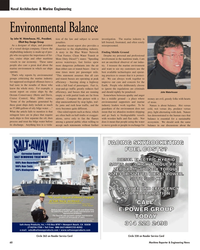 )
March 2, 2005 - Maritime Reporter and Engineering News page: 60
)
March 2, 2005 - Maritime Reporter and Engineering News page: 6060 Maritime Reporter & Engineering News by John W. Waterhouse, P.E., President, Elliott Bay Design Group As a designer of ships, and president of a vessel design company, I know the shipbuilding industry is made up of peo- ple who recognize the importance of fer- ries, cruise ships and other maritime
